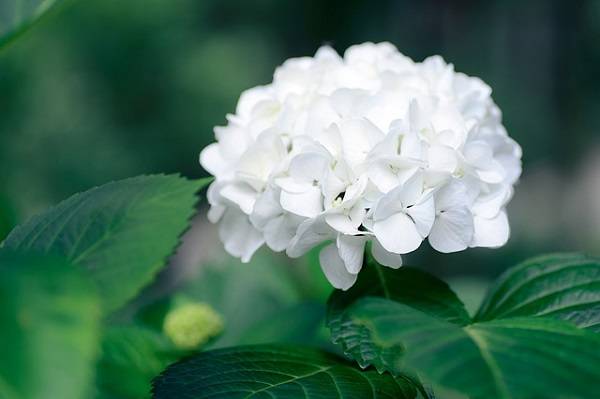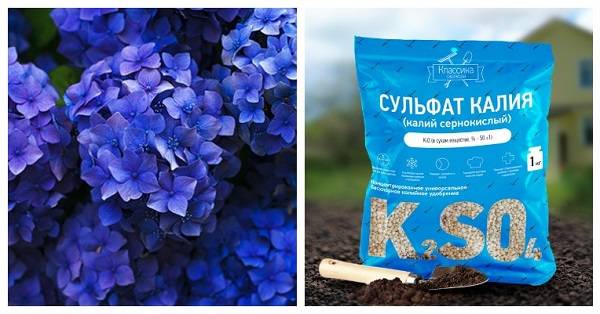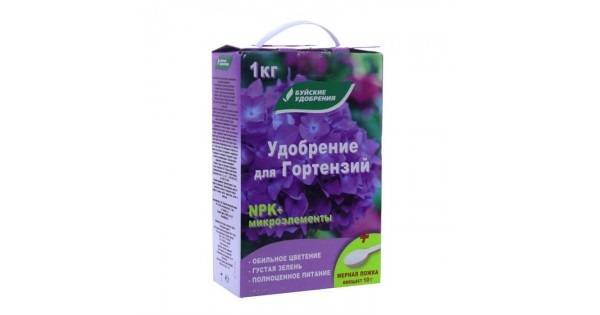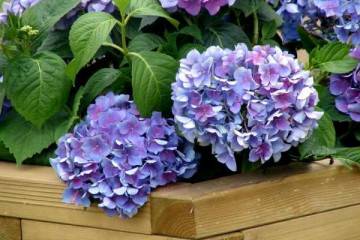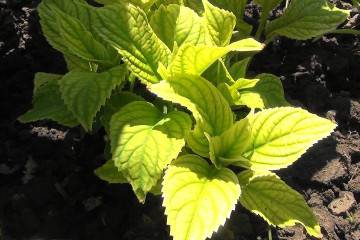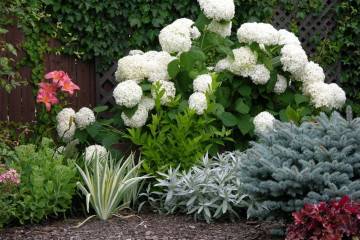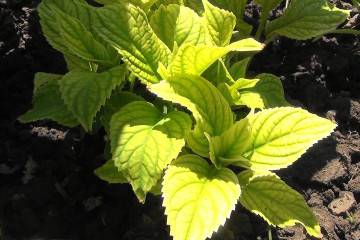How to acidify the soil for hydrangea - methods and proportions
Content:
Hydrangea, or hydrangea, in natural conditions can be found in North America, Japan, China. Most often it is a tree-like shrub with large flowers. Inflorescences are corymbose or paniculate. Trees and lianas are less common. The color is predominantly white. At home (and in the garden), hydrangeas and other shades are grown: blue, lilac, pink, red. These colors are obtained artificially as a result of changes in the pH of the soil. The article describes how to acidify hydrangea soil, with what and in what proportions.
What kind of soil does hydrangea like: acidic or alkaline
The flower is picky about the composition of the soil. He needs an airy loose soil for growth and development. The acidity level is much more important. The plant prefers acidic soil.
The acidity and color of hydrangeas
The color of the flowers depends directly on the acidity:
- pH <5 gives a blue color (most popular among florists);
- pH = 5.5, 6.5 (neutral soil) - beige;
- pH> 6.5 (alkaline) - pink, purple flowers.
By increasing or decreasing the acidity, you can get the desired color. In order for the flowers to acquire the original blue color, a good assimilation of aluminum is necessary, which is possible only in acidic soil. If it is lacking, there may be a blue color. To get pink, you need to slightly deoxidize the soil by adding lime, dolomite flour. Alkali is introduced starting in mid-March. However, do not exceed the indicator, since the likelihood of chlorosis will be high.
How can you acidify the soil for garden and home hydrangeas: means and proportions
How to acidify the soil for hydrangeas for interesting shades? Simple organic remedies, which are always at home, as well as mineral preparations, come to the rescue.
Lemon acid
Citric acid is recommended for hydrangea: proportions - 1.5 tbsp. spoon for 5 liters 1-2 times every 30 days or lemon juice.
Table vinegar
Food vinegar (9%) in a ratio of 100 g to 2 buckets of water (about 10 liters). Thoroughly dilute and spill the soil near the trunk.
succinic acid
Succinic acid is a real fertilizer for shrubs. Helps with the initial stages of diseases, as well as to get used to a new place of growth under unfavorable conditions. For prophylaxis, 2 g of acid must be diluted in a small amount of water at room temperature. After dissolving the crystals, add another 2 l. The frequency of watering is once every 14 days.
Apple vinegar
Excellent acidifier. Take 50 ml of vinegar per 12 liters of water. It takes about 10 buckets to irrigate 1 m². The entire bush is processed during sap flow and until the very end of the growing season. The break between treatments is 2 weeks.
Oxalic acid
It is used for slight acidification, as well as to maintain an optimal balance of alkali and acid. For 100 ml of acid, take 10 liters of pure water. Watered with a break of 14 days.
Mineral oxidants
Of the minerals for acidifying the earth, aluminum and sulfur are suitable. For irrigation, irrigation is also carried out with aluminum sulfate in the amount of 15 g per 1 liter of water.
Colloidal sulfur is applied directly to the soil 15 cm deep. It is recommended to apply the mineral in the fall. In the spring, after the snow melts, the required chemical reaction will begin in the ground, and after six months the acidity will drop by 2.5 pH.
Iron sulfate helps to get quick results. Introduce before the onset of the first frost (0.5 kg of substance per 10 m²). During the quarter, the acidity will decrease by 1 division.
For a slight change in the pH of the earth, potassium sulfate, ammonium nitrate or ammonium sulfate are used.
Thus, there is a decent choice than to acidify the hydrangea.
Organic
For flowering and increasing immunity, you can feed with fermented milk products with lactobacilli in the composition. Take whey (2 L) in a bucket of water. Apply after simple watering. This solution can be used for spraying foliage. To oxidize the soil, bark, sawdust, peat are suitable.
How to acidify the soil for hydrangea: technology
Top dressing to increase the acidity of the soil begins to be applied at the very beginning of the growing season, every 14 days. As a rule, they are carried out after regular watering.
Measure the acidity level of the soil
First, the pH level is measured to know how much to increase or decrease the acidity level. To do this, use litmus paper (in the form of a test strip).
A simple and effective method is the use of baking soda. It is scattered on the ground. If the acidity is too high or low, the grains will fly apart. Vinegar also helps determine the acid-base balance of the soil. When watering on alkaline soil, foam forms on the surface.
Apply the oxidizing agent correctly
To obtain the effect of acidification, an oxidizing agent must be used correctly. For this, the pH is determined (by the methods described above). The soil should be loose: it is easier to acidify it.
When a slight change in pH is required, organic is used. For example, peat, foliage, needles, sawdust, etc. These substances act slowly as they decompose. If necessary, to quickly raise the acidity, minerals and potent chemicals (ammonium nitrate, potassium sulfate) are introduced.
How to maintain the resulting acid-base balance
The soil is usually pH neutral. And for this reason, watering hydrangeas with citric acid (proportions: 1.5 tablespoons per bucket of water) will be the optimal method of acidification. You can water it by other means, but lemon is softer.
An exception when it is not necessary to add an oxidizing agent is the flowering period. After a while, oxidation will still be required.
What means to increase the amount of alkali back
How to make the soil acidic for hydrangeas? Carry out acidification through watering, maintaining the pH at a constant level of 5.5. There may be a need for the opposite process - a decrease in acidity, despite the plant's great love for acidified soil.
Here, too, you need to know when to stop. When the indicator reaches 6.5, a lack of nutrients appears, which is immediately reflected in the shrub. As a result, the plant can get sick and die.
To correct the current situation and reduce acidity, they begin to fertilize with products containing calcium carbonate in the composition. These include:
- dolomite flour (additionally contains magnesium ions, which is useful for hydrangeas);
- slaked lime;
- a piece of chalk;
- furnace ash (acts faster than other agents due to alkaline potassium compounds).
These substances help to free the soil from aluminum salts, which increase acidity. To make the soil neutral, never use baking soda.
Preparations with calcium do not lead to an alkaline reaction. Only by reacting with aluminum, a salt is formed that is soluble in water - calcium chloride. Aluminum, on the other hand, precipitates during the interaction. This leads to an increase in alkali and neutralization of soil acid. This takes some time.
The approximate amount of substance per 1 m² is 200 g. It is also affected by the acidity level that needs to be reduced.
Hydrangea is a beautiful graceful plant that can decorate both a garden plot and the interior space of a house and apartment. Its peculiarity lies in changing the color of flowers, depending on the level of acidity of the soil. By increasing the acidity, you can get beautiful blue shades, while decreasing it - pink, lilac. The decorativeness of the plant makes it one of the favorites in landscape design.
